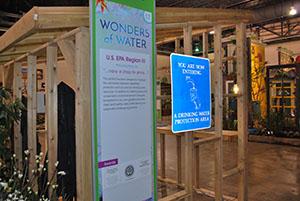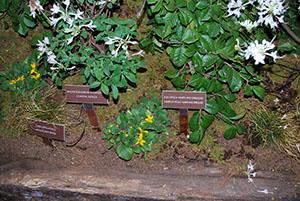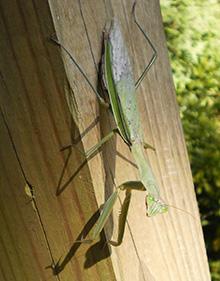EPA at the Philadelphia Flower Show
EPA's 2018 Exhibit
EPA's exhibit, "The Wonders of Water" was presented at the 2018 Philadelphia Flower Show Exitin March. The Flower Show is held every Spring in the Pennsylvania Convention Center Exit .
The exhibit represented the connection between headwater streams and wetlands and the vital role they play in the overall health of downstream waters. Visitors viewed a small headwater stream shaded with beautiful native trees such as ma EPA’s exhibit at the 2018 show, "Wonders of Water"gnolia, fringe tree, flowering dogwood, and the sweet fragrance of azaleas. The exhibit included a wetland bog teeming with wild and unique botanical beauty such as the carnivorous pitcher plant, exquisite swamp pinks, and magical fairy wands.
EPA’s exhibit at the 2018 show, "Wonders of Water"gnolia, fringe tree, flowering dogwood, and the sweet fragrance of azaleas. The exhibit included a wetland bog teeming with wild and unique botanical beauty such as the carnivorous pitcher plant, exquisite swamp pinks, and magical fairy wands.
EPA's exhibit highlighted the use of native plants to create a low-impact landscape and protect watersheds. The environmental benefits of these native plants include providing buffers for aquatic resources that help naturally manage stormwater, which can directly improve or maintain healthy water quality.
Our exhibit volunteers engaged with the public on the connection of healthy aquatic resources to drinking water and provided visitors with information on the benefits of using native plants, sustainable landscaping and stormwater management practices to instill positive ways of protecting our water.
The exhibit earned three awards:
- The Buckley Medal of the Garden Club of America
- The PHS Silver Medal
- The Alfred M. Campbell Memorial Trophy
Native Plants
 A close up of flowers at the 2018 EPA Exhibit.
A close up of flowers at the 2018 EPA Exhibit.
Environmental benefits of using native plants extend to other areas that visitors may not have considered:
- discouraging insect pests
- conserving water resources
- protecting endangered plants
- attracting beneficial insects
- conserving water and improving water quality
- reducing the use of pesticides
Using native plants in gardens may also save time and money otherwise spent on fertilizer, water and pesticides to grow non-native plants.
Examples of native plants that attract beneficial insects include: A large praying mantis - a beneficial insect - on a wood post in a garden
A large praying mantis - a beneficial insect - on a wood post in a garden
- Blueberry - attracts bumblebee pollinators
- Hackberry - host plant for the Hackberry butterfly, Eastern Comma, Mourning Cloak and Tawny Emperor
- Spicebush - host plant for the Spicebush Swallowtail and Promethean Moth
- New Jersey Tea - host plant for the Spring Azure butterfly
The use of native plants is part of a set of practices called integrated pest management, which is a common-sense way of managing pests through biological, cultural, physical, and chemical tools that minimize risks to people and the environment.
In other words, start with prevention; if a pest or weed problem develops, use an integrated approach to solve the problem. Learn more about Integrated Pest Management (IPM) Principles.
Learn more about sustainable landscaping practices used in residential settings: What Is Green Infrastructure? and Soak up the Rain.
